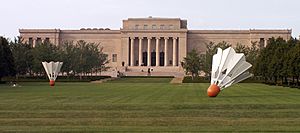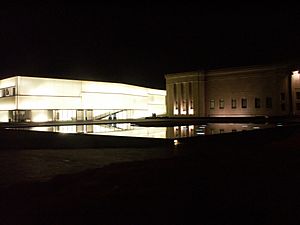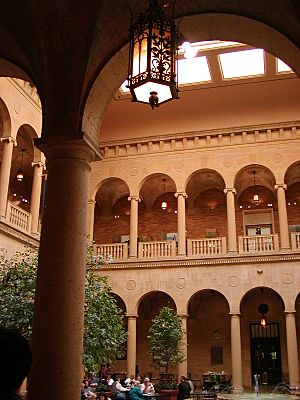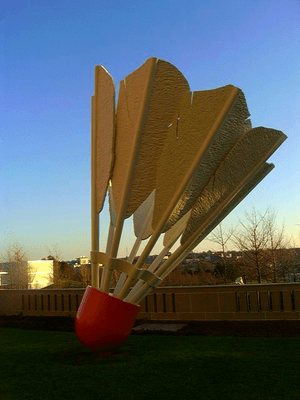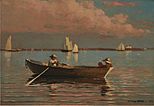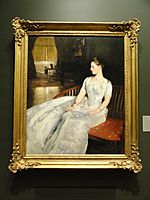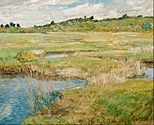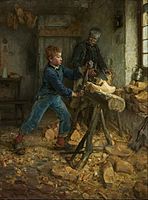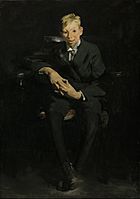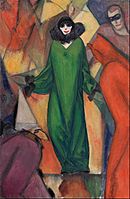Nelson-Atkins Museum of Art facts for kids
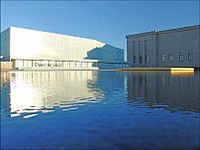 |
|
| Established | 1933 |
|---|---|
| Location | 4525 Oak Street, Kansas City, Missouri, United States |
The Nelson-Atkins Museum of Art is an art museum in Kansas City, Missouri, known for its encyclopedic collection of art from nearly every continent and culture, and especially for its extensive collection of Asian art.
In 2007, Time magazine ranked the museum's new Bloch Building number one on its list of "The 10 Best (New and Upcoming) Architectural Marvels" which considered candidates from around the globe.
On September 1, 2010, Julián Zugazagoitia (b. 1964) became the museum's fifth Director. Zugazagoitia had previously served for seven years as the Director and CEO of El Muséo del Barrio in New York City.
The museum is open five days a week: Monday from 11 am-5pm, Thursday 11-9, Friday 11-5, Saturday and Sunday 10-5. Museum members are admitted one hour earlier on weekdays. It is closed on Tuesday and Wednesday.
Admission is free.
Contents
History
The museum was built on the grounds of Oak Hall, the home of Kansas City Star publisher William Rockhill Nelson (1841-1915). When he died in 1915, his will provided that upon the deaths of his wife and daughter, the proceeds of his entire estate would go to purchasing artwork for public enjoyment. This bequest was augmented by additional funds from the estates of Nelson's daughter, son-in-law and attorney.
In 1911, former schoolteacher Mary McAfee Atkins (1836-1911), widow of real estate speculator James Burris Atkins, bequeathed $300,000 to establish an art museum. Through sound management of the estate, this amount grew to $700,000 by 1927. Original plans called for two art museums based on the separate bequests (with the Atkins Museum to be located in Penn Valley Park). However, trustees of the two estates decided to combine the two bequests along with smaller bequests from others to make a single major art institution.
The building was designed by prominent Kansas City architects Wight and Wight, who also designed the approaches to the Liberty Memorial and the Kansas governor's mansion, Cedar Crest. Ground was broken in July 1930, and the museum opened December 11, 1933. The building's classical Beaux-Arts architecture style was modeled on the Cleveland Museum of Art Thomas Wight, the brother who did most of the design work for the building said:
We are building the museum on classic principles because they have been proved by the centuries. A distinctly American principle appropriate for such a building may be developed, but, so far, everything of that kind is experimental. One doesn't experiment with two-and-a-half million dollars.
When the original building opened, its final cost was $2.75 million (about $54 million in 2018). The dimensions of the six-story structure were 390 feet (120 m) long by 175 feet (53 m) wide, making it larger than the Cleveland Museum of Art.
The museum, which was locally referred to as the Nelson Art Gallery or simply the Nelson Gallery, was actually two museums until 1983 when it was formally named the Nelson-Atkins Museum of Art. Previously the east wing was called the Atkins Museum of Fine Arts, while the west wing and lobby was called the William Rockhill Nelson Gallery of Art.
On the exterior of the building Charles Keck created 23 limestone panels depicting the march of civilization from east to west including wagon trains heading west from Westport Landing. Grillwork in the doors depict oak leaf motifs in memory of Oak Hall. The south facade of the museum is an iconic structure in Kansas City that looms over a series of terraces onto Brush Creek.
About the same time as the construction of the museum, Howard Vanderslice donated 8 acres (32,000 m2) to the west of the museum, across Oak Street, for the Kansas City Art Institute, which moved from the Deardorf Building at 11th and Main streets in downtown Kansas City.
As William Nelson, the major contributor, donated money rather than a personal art collection, the curators were able to assemble a collection from scratch. At the height of the Great Depression, the worldwide art market was flooded with pieces for sale, but there were very few buyers. As such, the museum's buyers found a vast market open to them. The acquisitions grew quickly and within a short time, the Nelson-Atkins had one of the largest art collections in the country.
One of the original components of the building was a recreation of Nelson's oak paneled room from Oak Hall (and namesake of the estate). The room contained Nelson's red plush easy chair and bookcases. The room was dismantled in 1988 to make way for a photography studio.
One-third of the building on the first and second floors of the west wing were left unfinished when the building opened to allow for future expansion. Part was completed in 1941 to house Chinese painting and the remainder of the building was completed after World War II. In 1993 Michael Churchman wrote a history of The Nelson-Atkins Museum of Art, High Ideals and Aspirations.
Directors
Paul Gardner, 1933-1953
The museum had four Directors before Julián Zugazagoitia's appointment in 2010; the first was Paul Gardner (1894-1972). A native of Massachusetts, Gardner graduated from MIT in 1917 with a degree in architecture. He served with distinction in WWI, after which he traveled in Europe and North Africa for a year. In about 1919 he became a dancer with Anna Pavlova's Ballet Company under the name “Paul Tchernikoff”. Gardner eventually went back to graduate school, earning a master's in European history from George Washington University in 1928 and then enrolling in the doctoral program in art history at Harvard. In March 1932 the cautious Trustees of the Nelson Art Gallery, hesitant about naming a full-fledged Director, appointed the graduate student as their assistant on a trial basis. Gardner took to the new position at once, and so was named by the Trustees as Director eighteen months later, on September 1, 1933. He would serve for the next twenty years.
Ethylene Jackson, 1942-1945
Ethylene Jackson (1907-1993), Paul Gardner's executive secretary since 1933, became acting director in November 1942 when Gardner was commissioned a major in the United States Army. Besides her role as executive secretary to the Director, Jackson had served as curator of the decorative arts collection. Paul Gardner served as a Monuments Man in Europe, returning to the Nelson in December 1945. Ethylene Jackson left Kansas City for New York City the following year after marrying art dealer Germain Seligman.
Laurence Sickman, 1953-1977
Upon Paul Gardner's retirement on May 1, 1953, Laurence Sickman (1907-1988) became the Gallery's second Director. He had been associated with the Gallery since 1931.
Laurence Sickman, a native of Denver, Colorado, had become interested in Japanese and Chinese art as a high school student. After two years at the University of Colorado he transferred to Harvard, where he studied with Langdon Warner. He also became fluent in Chinese. After graduating with a B.A. in 1930 Sickman traveled to China on a Harvard-Yenching scholarship. There he reconnected with Warner, who was by then in China, under assignment to buy art for the museum Trustees. Warner recommended to the Trustees that the young graduate student assume the responsibility of negotiating art purchases for the Gallery, as Warner was moving to Japan. Sickman's acumen as a collector earned him the respect of the Trustees, who sent him thousands of dollars with which to buy art. Since he was on a scholarship, his expertise cost the Trustees nothing. He made the 6,000-mile journey to Kansas City in December 1933 for the opening of the Gallery, then returned to China. Returning once more to the United States, he was made the Gallery's Curator of Oriental Art in 1935. By 1941, Sickman's purchases of Chinese art had given the Nelson Gallery one of the best Asian collections in the United States.
Sickman, like Paul Gardner, was commissioned as an officer in the United States Army as a member of the Monuments Men, serving from 1942 to 1945 in England, India, and China. In his absence, his very capable assistant, Miss Lindsay Hughes, was appointed acting Curator. Sickman returned to his curatorial role after the war; eight years later he was named Director. Among the many successes of his tenure, the most important was the major exhibition “Archaeological Finds of the People's Republic of China”, which ran from April 20-June 8, 1975 and attracted about 280,000 visitors. The exhibition of 385 pieces was a result of the détente between the United States and Communist China that Richard Nixon's 1972 trip to that country had begun. This was a professional and personal coup for Sickman: his reputation as a scholar and the collection he had built at the Nelson Gallery made Kansas City one of only four cities the exhibition would visit, after Paris, Toronto, and Washington, D.C. Laurence Sickman retired on January 31, 1977, and was named Director Emeritus and advisor to the Trustees.
Ted Coe, 1977-1982
On Laurence Sickman's retirement, Ralph Tracy “Ted” Coe (1929-2010) became the Gallery's third Director. Coe was a native of Cleveland, where his father, a steel manufacturer, was an art collector. The recipient of a bachelor's degree in art history from Oberlin College and a master's in architecture from Yale, he had worked at the Victoria and Albert Museum in London and the National Gallery in Washington, D.C. before coming to the Nelson Gallery in 1959 as Curator of Painting and Sculpture. While a curator, Coe organized several large and well-attended special exhibitions. The most influential was “Sacred Circles”, an exhibition of 900 Native American art objects. Organized to commemorate the American Bicentennial, the show opened at the Hayward Gallery in London, England, running from October 1976 to January 1977. Financial support was quickly organized in Kansas City to make the Nelson Gallery the only American venue. “Sacred Circles” was the second most popular exhibition after the Chinese show of 1975, running from April 16-June 19, 1977, and drawing more than 245,000 visitors. Ted Coe requested a sabbatical from his duties as Director in March 1982 and resigned at the end of June, having worked at the Nelson for 23 years, including 4½ years as Director.
Marc Wilson, 1982-2010
Ted Coe was succeeded by Marc Wilson, who served from 1982 to 2010.
Bloch Building Addition
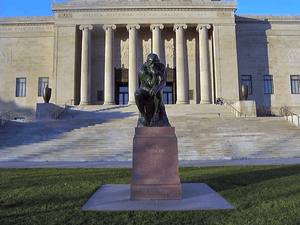
In 1993, the museum began to consider the first expansion plans since the completion of the unfinished areas in the 1940s. Plans called for a 55 percent increase in space and were finalized in 1999.
Architect Steven Holl won an international competition in 1999 for the design of the addition. Holl's concept, conceived and realized with Design Partner Chris McVoy, was to build five glass pavilions to the east of the original building which they call lenses. The lenses top a 165,000-square-foot (15,300 m2) underground building known as the Bloch Building. It is named for H&R Block co-founder Henry W. Bloch. The Bloch building houses the museum's contemporary, African, photography, and special exhibitions galleries as well a new cafe, the museum's Spencer Art Reference Library, and the Isamu Noguchi Sculpture Court. The addition cost approximately $95 million and opened June 9, 2007. It was part of $200 million in renovations to the museum that included the Ford Learning Center which is home to classes, workshops, and resources for students and educators. It opened in fall of 2005.
In the competition to design the addition, all the entrants except Holl proposed creating a modern addition on the north side of the museum which would have drastically altered or obscured the north facade which served as the main entrance to the museum. Instead Holl and McVoy proposed placing the addition on the east side perpendicular to the main building. Their aim was to engage the museum's iconic sculpture garden to fuse the experience of art, architecture and landscape. Their lenses now cascade down the east perimeter of the grounds.
During construction, Holl's plan met with considerable controversy. It was described as “grotesque, a metal box.” However, reviews of the new structure once completed have generally been raves:
New York Times architecture critic Nicolai Ouroussoff gives this description:
For the art world, the addition, known as the Bloch Building, should reaffirm that art and architecture can happily coexist. The rest of us can draw comfort from the fact that public works of our own day and age can equal or surpass the grand achievements of past generations ...
The result is a building that doesn't challenge the past so much as suggest an alternate world view that is in constant shift. Seen from the north plaza, the addition's main entrance gently defers to the old building, the crystalline form suggesting a ghostlike echo of the austere stone facade. From there, the eye is drawn to the distinct yet interconnected translucent blocks, which are partly buried in the landscape ...
It's an approach that should be studied by anyone who sets out to design a museum from this point forward.
The museum has gone against traditional conservatorial thinking in allowing natural light from the lenses to illuminate its art work. Most of the exhibits in the addition are below ground with the 27 to 34-foot (10 m) glass pavilions above them. Officials say that advances in glass technology have allowed them to block most of the harmful ultraviolet rays that could damage the exhibited works.
The custom glass planks were manufactured by Glasfabrik Lamberts and imported by Bendheim Wall Systems.
Admission to the museum is free every day and visitors may use any of seven entrances to access the building. The main visitor's desk is in the Bloch Building. On the north side of the museum, a reflecting pool now occupies part of the J.C. Nichols Plaza on the north facade and contains 34 oculi to provide natural light into the parking garage below. The casting of The Thinker which occupied this space prior to the renovations has been relocated to south of the museum.
In 2013, the combination of Steven Holl Architects and BNIM was selected to build a $100 million addition to the John F. Kennedy Center for the Performing Arts that will be modeled somewhat on the Bloch Addition.
Collections
European painting
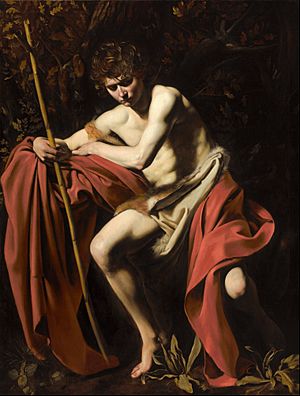
The museum's European painting collection is highly prized. It includes works by Caravaggio, Jusepe de Ribera, Jean-Baptiste-Siméon Chardin, Petrus Christus, El Greco, Giambattista Pittoni, Guercino, Alessandro Magnasco, Giuseppe Bazzani, Corrado Giaquinto, Cavaliere d'Arpino, Gaspare Traversi, Giuliano Bugiardini, Titian, Rembrandt, Louise Élisabeth Vigée Le Brun, and Peter Paul Rubens, as well as Impressionists Gustave Caillebotte, Edgar Degas, Paul Gauguin, Claude Monet, Camille Pissarro and Vincent van Gogh, among others.
In early 2016, The Temptation of St. Anthony, a small panel long attributed to the workshop of Hieronymus Bosch, was credited to the painter himself after forensic investigation of its underpainting; it was added to the ranks of only 25 authenticated Bosch paintings in the world. The Nelson-Atkins also has fine Late Gothic and Early Italian Renaissance paintings by Jacopo del Casentino (The Presentation of Christ in the Temple), Giovanni di Paolo and Workshop, Bernardo Daddi and Workshop, Lorenzo Monaco, Gherardo Starnina (The Adoration of the Magi), and Lorenzo di Credi. It has German and Austrian Expressionist paintings by Max Beckmann, Karl Hofer (Record Player), Emil Nolde, Ernst Ludwig Kirchner and Oskar Kokoschka (Pyramids of Egypt).
Asia
The museum is distinguished (and widely celebrated) for its extensive collection of Asian art, especially that of Imperial China. Most of it was purchased for the museum in the early 20th century by Laurence Sickman, then a Harvard fellow in China. The museum has one of the best collections of Chinese antique furniture in the country, including one of the celebrated group of glazed pottery luohans from Yixian (c. 1000). In addition to Chinese art, the collection includes pieces from Afghanistan, Japan, India, Iran, Indonesia, Korea, Pakistan, and Southeast, and South Asia.
American painting
The American painting collection includes the largest collection open to the public of works by Thomas Hart Benton, who lived in Kansas City. Among its collection are paintings by George Bellows, George Caleb Bingham, Frederic Church, John Singleton Copley, Thomas Eakins, Winslow Homer, and John Singer Sargent. It also has fine Contemporary Paintings and Creations in the Bloch Building by Willem de Kooning, Fairfield Porter (Mirror), Wayne Thiebaud (Bikini Girl), Richard Diebenkorn, Agnes Martin, Bridget Riley, and Alfred Jensen.
- American painting
-
Winslow Homer, Gloucester Harbor, 1873, gift of the Enid and Crosby Kemper Foundation
-
John Singer Sargent, Mrs. Cecil Wade, 1886
-
Henry Ossawa Tanner, The Young Sabot Maker, 1895
-
George Bellows, Frankie, the Organ Boy, 1907
Photography
In 2006, Hallmark Cards chairman Donald J. Hall, Sr. donated to the museum the entire Hallmark Photographic Collection, spanning the history of photography from 1839 to the present day. It is primarily American in focus, and includes works from photographers such as Southworth & Hawes, Carleton Watkins, Timothy O'Sullivan, Alvin Langdon Coburn, Alfred Stieglitz, Dorothea Lange, Homer Page, Harry Callahan, Lee Friedlander, Andy Warhol, Todd Webb, and Cindy Sherman, among others.
Native American
In 2009, the museum opened a suite of Native American art galleries, totaling 6,100 square feet, among the largest such displays in a comprehensive art museum. The gallery includes the art of Jamie Okuma, a Luiseño and Shoshone-Bannock artist known for her beadwork, mixed media small sculpture, and fashion art.
Donald J. Hall Sculpture Park
Outside on the museum's immense lawn, the Donald J. Hall Sculpture Park, designed by Dan Kiley, contains the largest collection of monumental bronzes by Henry Moore in the United States. The park also includes works by Alexander Calder, Auguste Rodin, George Segal and Mark di Suvero, among others. Beyond these, the park (and the museum itself) is well known for Shuttlecocks, a four-part outdoor sculpture of oversized badminton shuttlecocks by Claes Oldenburg and Coosje van Bruggen.
Other
In addition, the museum also has collections of European and American sculpture, decorative arts and works on paper, Egyptian art, Greek and Roman art, modern and contemporary paintings and sculpture, and the art of Africa and Oceania. The museum also houses a major collection of English pottery and another of portrait miniatures.
Images for kids
See also
 In Spanish: Museo de arte Nelson-Atkins para niños
In Spanish: Museo de arte Nelson-Atkins para niños


